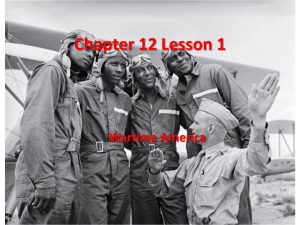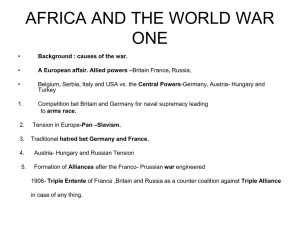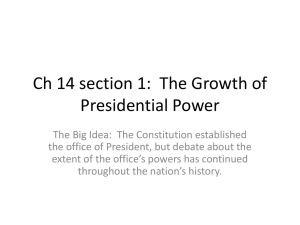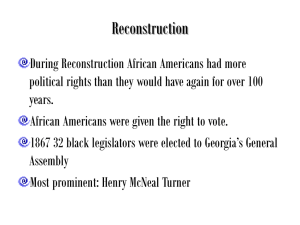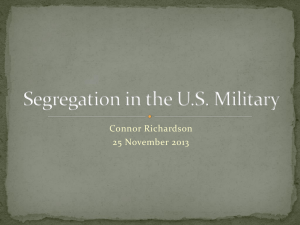Peace Operations
advertisement
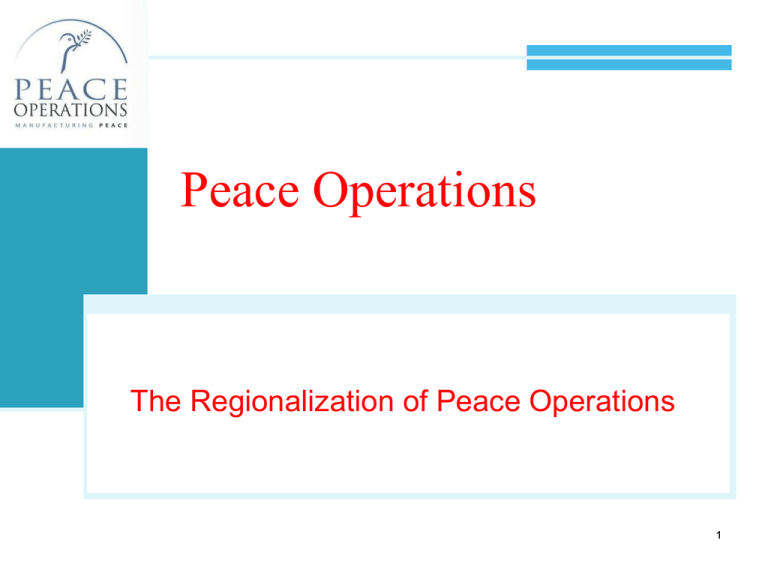
Peace Operations The Regionalization of Peace Operations 1 Content 1) Conceptual challenge and Political issue 2) Legal aspects 3) Historical evolution 4) Advantage et inconvenient 5) Inventory 6) New trend: interinstitutional cooperation 7) Conclusion 2 1. Conceptual challenge and political issue 1.1. Various meanings (positive) • Increasing RO involvement in Peace Operations • Selective commitment of Big Powers • Regional contributing countries 3 1. Conceptual challenge and political issue (2) 1.2. Various meanings (Negative) • Fading out of UN role • Lack of interest of Western powers for “out-of-area” conflicts • Withdrawal of Western powers from selected areas 4 2. Legal aspects UN Charter : Chapter VIII • Art.52 §1 : « do not prevent » if « compatible » • §2 et 3 : implicit subsidiarity principle (Chapter VI) • Art.53 : SC monopole for coercive action (Chapter VII) 5 3. Historical evolution 3.1. An agenda for peace (1992) • Increasing role of RO • Pragmatic approach • Method: subordination • UN AG Resolution (1993) 6 3. Historical evolution (2) 3.2. Supplement to An Agenda for Peace 4 methods of cooperation: • Consultation • Diplomatic support • Task sharing • Joint operation 7 3. Historical evolution (3) 4 principles: • UN-RO consultation mechanisms • United Nations primacy • Clear tasks sharing • Consistency of member states action 8 3. Historical Evolution (4) 3.3. Brahimi Report (2000) • « Encourage UN-RO cooperation» • Disparity of RO capacities • Training and support to RO 9 3. Historical Evolution (4) 3.4. Recent trends • SC Presidential Statement • Increasing number of actors 10 11 4. Advantages and Inconvenient 4.1. Advantages • Proximity • Rapidity • Involvement and commitment • Higher consensus probability • Parties consent • Non involvement of external powers 12 4. Advantages and inconvenient 4.2. Inconvenient • Neutrality more difficult • Agenda of regional powers • Capacity • Legitimacy • External influence 13 4. Advantages and inconvenient 4.3. Underlying political debate • Central role of Security Council • Western troops under Blue Helmet? • Enhancement of regional peacekeeping capacities 14 5. Inventory 5.1. Organization of American States • RO recognized by UN • Non military contributions in the 90s (Salvador, Haiti) • No planning capacity for military operations 15 5. Inventory (2) 5.2. ASEAN • More a forum than an OR • Preference for UN action (Cambodia) • Ad hoc coalition (Eastern Timor) 16 5. Inventory (3) 5.3. European Union • Headline Goal (Helsinki 1999) : 60 000 soldiers • 13 « Battlegroups » • Shortfalls : strategic tpt., comm., intelligence • UE staff but no planning capacity « Berlin plus » 17 5. Inventory (4) 5.4. OSCE Support to peace operations (niche between EU and NATO) : • Reform of security sector • Election Process • Human rights monitoring 18 5. Inventory (5) 5.5. African Union • Peace and Security Council • Stand-by African Forces (FAA) • 1 brigade (5000 h.) in each of the 5 subregions • 6 scenarios • RECAMP, ACRI, ACOTA (African Contingency Operations Training and Assistance program) 19 5. Inventory (6) 5.6. NATO • Military alliance turned to regional security organization • Structures and efficiency inherited from the Cold War • Balkans : SFOR, IFOR, KFOR • Afghanistan : ISAF • NATO Response Force (NRF) : 17 000 . 20 6. New Trend : Interinstitutional Cooperation - Tasks Sharing (Afgh., Kosovo) - Sequential Deployment (Chad) - Joint Operation (« Hybrid ») 21 Joint Appointments Joint Special Representative Force Force Commander Commander Deputy Deputy Force Force Commander Commander Deputy Joint Representative Police Commissioner Deputy Police Commissioner 22 Peace and Security Council Security Council Commission Peace and Security Secretary General Darfur Desk DPKO Joint Support Coordination Mechanism Joint Special Representative UNAMID Security Council Peace and Security Council Commission UNSG Peace and Security Darfur Desk DPKO Joint Special Representative UNAMID Joint Support Coordination Mechanism 7. Conclusion • Various meanings of ‘Regionalization’ • Heterogeneity with Western supremacy • Primacy of UN Security Council? • Main Powers involvement? • Risk of proliferation of regional and subregional actors? 25 Peace and Security African Architecture Peace and Security Council Panel of the Wises African Peace Fund Peace and Security Department Chairman of the AU Commission Military Staff African Stand-By Forces IGAD Intergovernmental Authority for Development North Africa ECOWAS Economic Community of Western African States CEMAC SADC Communauté économique et monétaire de l’Afrique centrale South African Development Community 27 28 29 30 31 32 33 34



